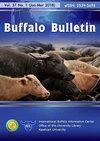Quality assessment and comparative study of somatic cell fluctuation at different lactation stages of buffalo's milk
IF 0.2
4区 农林科学
Q4 AGRICULTURE, DAIRY & ANIMAL SCIENCE
引用次数: 0
Abstract
The aim of current study is to check the health status and the quality of milk by counting somatic cells. Total 50 samples of fresh raw buffalo milk were gathered and divided into five groups on the basis of lactation stages i.e early, mid, late, buffalo at parturition and post parturition (colostrum). Fresh samples were collected and assessed with quality assessment test i.e. pH analysis, lactometer reading test, clots on boiling (COB), alcohol precipitate test (APT) and acidity % age test and the somatic cell count (SCC) through Neubauer chamber under light microscope. Data were evaluated by the stage of lactation with the SPSS programme. The total mean values of pH, Lr and acidity % at each lactation stages were (±6.96, ±31 and ±0.19). Significant effect of SCC on different stages were observed (P<0.05). The average SCC was determined to be 10.1000±5.8121 cells/ml. The effects lactation stages on the SCC value between group were statistically significant (P<0.05). The mean SCC values for early, mid, late, parturition and post parturition stages were (±6.4750, ±5.7500, ±10.8750, ±16.2750 and ±11.1250). The significant differences recognized between the groups indicates that there is a fluctuation of somatic cells at different lactation stages. The number of somatic cells increase from early stage, then decrease gradually in mid stage and starts increasing till the end of lactation and have no significant difference (P<0.05), whereas the mean comparison is highly significant in parturition and colostrum stage.水牛奶不同哺乳期体细胞波动的质量评估和比较研究
本次研究的目的是通过计数体细胞来检查牛奶的健康状况和质量。研究人员共收集了 50 份新鲜水牛奶样本,并根据泌乳阶段(即早期、中期、晚期、临产水牛和产后(初乳))分为五组。收集新鲜样本并进行质量评估测试,即 pH 值分析、泌乳计读数测试、沸腾凝块(COB)、酒精沉淀测试(APT)和酸度 % 年龄测试,以及在光学显微镜下通过 Neubauer 室进行的体细胞计数(SCC)。数据按泌乳阶段用 SPSS 程序进行评估。各泌乳阶段的 pH 值、Lr 值和酸度%的总平均值分别为(±6.96、±31 和 ±0.19)。观察到 SCC 对不同阶段有显著影响(P<0.05)。平均 SCC 为 10.1000±5.8121 cells/ml。泌乳阶段对各组间 SCC 值的影响具有统计学意义(P<0.05)。早期、中期、晚期、分娩期和分娩后的平均 SCC 值分别为(±6.4750、±5.7500、±10.8750、±16.2750 和 ±11.1250)。各组之间的明显差异表明,体细胞在不同的哺乳阶段存在波动。体细胞数从泌乳初期开始增加,到中期逐渐减少,直到泌乳末期才开始增加,差异无显著性(P<0.05),而在产仔和初乳阶段,平均值比较具有高度显著性。
本文章由计算机程序翻译,如有差异,请以英文原文为准。
求助全文
约1分钟内获得全文
求助全文
来源期刊

Buffalo Bulletin
AGRICULTURE, DAIRY & ANIMAL SCIENCE-
CiteScore
0.50
自引率
0.00%
发文量
53
审稿时长
>12 weeks
期刊介绍:
Buffalo Bulletin is published quarterly in January-March, April-June, July-September and October-December. Contributions on any aspect of research or development, progress reports of projects and news on buffalo will be considered for publication in the bulletin.
 求助内容:
求助内容: 应助结果提醒方式:
应助结果提醒方式:


